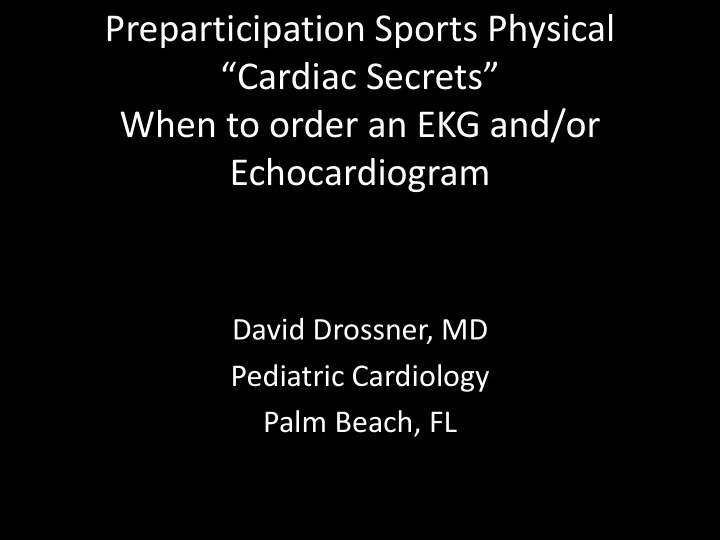

Preparticipation Sports Physical “Cardiac Secrets” When to order an EKG and/or Echocardiogram David Drossner, MD Pediatric Cardiology Palm Beach, FL
Disclosures • I wish, but none
Goal Ordering an EKG and/or echocardiogram as an adjunct to the preparticipation sports physical exam
Objectives 1. Define Sudden Cardiac Arrest and etiologies 1. Discuses top 3 cardiac conditions leading to SCA 1. Should all pediatric patients undergo EKG screening in addition to the PPE?
What is Sudden Cardiac Arrest?
What is Sudden Cardiac Arrest Sudden cessation of cardiac activity/pumping function resulting in hemodynamic collapse SCA ≠ Heart attack
Putting it in perspective
• SCA leading cause of death in school aged atheletes • 2,000 peds patients/year (at least) • Low survival rate • Under reporting • Often as no warning signs • 50% first symptom will be SCA
Comparison of published data from the US National Registry with the Parent Heart Watch database
1990 1 st edition 1992 12 point American Heart Assoc 1996 14 Element AHA 2014
Preparticipation Physical Exam AAP guidelines “Identify medical problems with risks of life - threatening complications during participation”
PPE 5 th Edition
PPE Florida Form
Hypertrophic Cardiomyopathy Coronary Abnormalities Channelopathies
HCM • 1/500 persons in the general population • 750K estimated to be affected by HCM – 100,000 diagnosed – Under recognition
HCM- A family disease • Autosomal Dominant • All about communication – Abnormal thickening – ICD – Death during sport – Heart transplant – Heart problems at an early age
HCM- Presenting Symptoms – Chest Pain – Presyncope/synco pe – Palpitations – SCA
HCM- explaining the symptoms Context matters!
HCM-physical exam • Cardiac murmur (53%) • Harsh systolic murmur • Dynamic auscultation – Valsalva preload – Standing
HCM and ambulatory testing EKG can be abnormal in over 90% of HCM patients* * Ryan MP, Cleland JG, French JA, et al. The standard electrocardiogram as a screening test for hypertrophic cardiomyopathy. Am J Cardiol 1995;76:689 – 94. 48 Maron BJ, Roberts WC, Epstein SE. Sudden death in hypertrophic cardiomyopathy: a profile of 78 patients. Circulation 1982;65:1388 – 94. Rowin EJ, Maron BJ, Appelbaum E, et al. Significance of false negative 49 electrocardiograms in preparticipation screening of athletes for hypertrophic
Coronary Artery Anomalies • 0.1-1% in adult and pediatric population • No suggested to be a familial/genetic disease • No physical exam findings • EKGs are normal • All about the history
Normal Coronary Artery Anatomy
Anomalous Right CA from Left Anomalous Left CA from Right
Sudden Cardiac Arrest Mechanism of action • Limited coronary reserve – Ostial stenosis – Compression of anomalous coronary artery intramurally or between great vessels • Exercise and SCA – Recreational >competitive
Clinical Presentation • Incidental diagnosis • SCA or aborted SCA • Chest pain with physical activity (ischemic) • Other symptoms with exertion
Anomalous Coronary Artery and Exercise All about history
Arrhythmia Disorders • Wolf Parkinson White Syndrome • Long QT syndrome • Ventricular Ectopy
WPW • 0.25% of the population – Bit higher in 1 st degree family members • Incidence of SCD in asymptomatic patient is low 0.13%/year • Symptomatic patients risk for SCA 0.25%/year – 3-4% lifetime risk
WPW- presenting symptoms • Palpitations (SVT) • Syncope • SCA (rare) • No physical exam findings
WPW and EKGs
WPW
Worst case Scenario
Long QT Syndrome • Disorder of ventricular myocardial repolarization • 1/2000 live births • Average age at 1 st symptom is 12 years – Increased # of asymptomatic Dxs
A Family Disease • Autosomal Dominant • Autosomal recessive • Key Questions – Unexplained • SCD <40 • MVA • Drownings
Long QT syndrome presenting signs • Syncope • Seizures • SCA • Context matters! – Swimming, diving, acute arousal, emotional stress – Physical exertion
Long QT Syndrome
Premature Ventricular Contractions CPVT Arrhythmogenic Cardiomyopathy • Familial disease • Fibro-fatty replacement of myocardium • Arrhythmia disorder • Frequently seen with • Bidirectional/polymorphic ventricular ectopy ventricular ectopy • VT/VF with physical activity
Premature Ventricular Contractions CPVT Arrhythmogenic Cardiomyopathy
When to order an EKG and/or echocardiogram as an adjunct to the preparticipation sports physical exam
Should a 12 lead EKG be incorporated within the preparticipation physical evaluation?
PPE, show me the data
Why No? • False Positives – Initial Italian study ~9% • False Negatives – Cardiomyopathy dynamic disease process • No data it reduces risk for SCD • Logistics
Cost • 10 million kids x $25= $250 million • Add EKG $50 each = $750 million • 15% false + rate= $2 billion per year program • $3.4 million dollar cost to prevent SCD
False +
Real World Experience Nevada HS 5,615 Sensitivity 70% vs 6% (EKG vs HP) North Carolina HS 2,017 H&P abnormal 14.7% compared to 3% EKG Chicago HS 32, 561 2.5% abnormal EKGs Texas Children's 2,506 Abnormal EKG 2.3% CHOP ~4,000 Abnormal EKG 2-3% (true + 0.7%)
Nicklaus Children’s Experience # of screenings 10000 8921 9000 7600 8000 6667 7000 6000 5000 4426 4107 # of screenings 4000 3000 2132 2000 728 1000 224 211 0 2011 2012 2013 2014 2015 2016 2017 2018 2019
Final Thoughts • Will EKG ever become apart of the PPE? • Why only athletes and not all pediatric patients? • Does artificial intelligence help logistics and cost?
In summary • Ordering an EKG and/or echocardiogram as an adjunct to the preparticipation sports physical exam – Define Sudden Cardiac Arrest and etiologies – Discuses top 3 cardiac conditions leading to SCA – Should all pediatric patients undergo EKG screening in addition to the PPE?
Recommend
More recommend